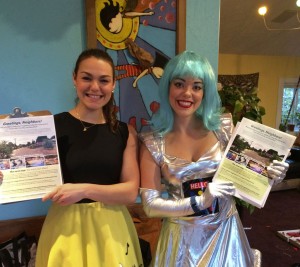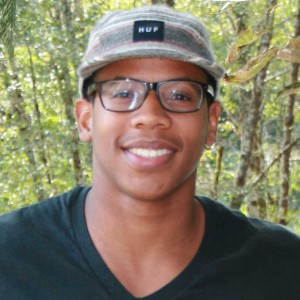City officials have put student groups to work in PPPM 408 “Real World Eugene” to identify and provide suggestions on some city issues around Eugene. These include encouraging millennial interaction with the city, helping develop a City-sponsored, residential composting pilot program, producing a guidebook and setting a precedent on how to engage in tactical urbanism, and providing insight about why college students are driving cars to campus.
On Halloween night, two University of Oregon students went door-to-door in the Friendly Neighborhood to engage neighbors and gather design ideas for a class initiative that would renovate a nearby intersection.
Neighbors who answered their doors didn’t find trick-or-treaters, but rather undergraduate students Jackie Stinson and Dianna Montzka, who shared their project on painting the 26th and Olive intersection.

“We wanted to take advantage of Halloween because we knew that’s the best chance we had for people to open their doors and welcome strangers,” says Montzka, an undergraduate architecture major. “Each house was overwhelmingly positive.
The 26th and Olive intersection is the only four-way intersection on College Hill without a stop sign says Bethany Steiner, course co-instructor and associate director of the PPPM Community Planning Workshop. City officials turned down a Friendly Neighborhood resident’s request for a stop sign to be mounted at the intersection, because the intersection’s accident rate wasn’t high enough to merit an installation.
So the group’s plan for an art installation in the road would theoretically encourage drivers to slow down, rather than speed through the intersection
Stinson and Montzka are working with other PPPM students Megan Knox, Morgan Greenwood and Bryce Yoshikawa in the “Tactical Urbanism” group – a term defined as “a short-term action that produces a long-term change.”
The group’s project, in collaborating with city officials, is a component of the 400-level PPPM course “Real World Eugene.” The course introduces PPPM students with Eugene city officials to practice professional work within the city.
Other class projects include: forming a contaminant notification system for a pilot residential composting program in Eugene, studying students’ driving patterns to and from campus, and identifying how the city can best engage millennials in community decision-making.
City officials initiated all the course’s projects.
“It’s part of our goal to utilize students’ creativity, expertise, and energy to help the city solve problems,” says Steiner. “It’s a really cool way to run a class.”
The group’s objective is to create a free guidebook, specific to Eugene, about the process of tactical urbanism.. The goal is for community members to be able to enact similar undertakings, with the support of the local government. The guidebook will include a step-by-step process; what grants are available from the city; and a contact list of who to consult.
Stinson says the guidebook’s intention is to provide neighbors more information on taking action and make the task of “tactical urbanism” less daunting.
“I think the guidebook would benefit the community. It’s something a lot of people know about or have heard about, but aren’t quite sure how to do it,” says Jason Dedrick, a policy analyst for the City of Eugene. “There are things related to tactical urbanism online; this will personalize it, make it more about Eugene, and benefit community members.”
Dedrick connects all four groups with community officials. He says that the course work lets students try their hand at city planning and policy work.
“Students have a different lens, and are willing to ask questions that other [city officials] wouldn’t think to ask,” says Dedrick. “For us, it really helps to tighten [the City’s] relationship with the university.”
Steiner and Bob Parker, course co-instructor and director of the Community Service Center, were awarded the Williams Fund to finance and authorize the course, being taught for its very first term.
“This idea of undergraduates doing real-world work is really experimental; it could have not worked at all. The Williams Fund allowed us to take that risk and see how it works,” says Steiner.
Parker adds, “Real World Eugene is a unique opportunity for students to work on pressing community problems that are important to the City and to the community. It’s been very exciting to observe how the students engage in what amount to complicated community issues and how the work together to creatively problem solve. For the students, it’s a unique experience that cannot be replicated in the classroom.”
Another student group is working with the City on developing a contaminant notification system for the City’s pilot, residential composting program. This system is an integral part of the composting program and must be figured out before the pilot can go live.
The class’s “College Student Vehicle Use” group is working with the City of Eugene’s transportation planning division to investigate why students drive to campus. The group includes students Corum Ketchum, Madeleine McNally, Max Morrison, and Mitch Koch.
The group visited different student-housing complex’s parking lots and garages throughout Eugene (such as 13th and Olive, Ducks Village, and the Hub) at nighttime, and again the following morning, and after classes, between 10 a.m and 2 p.m. when students’ cars would be used. “By dividing the cars in the morning by the cars at night gives us the number of cars that left,” says Ketchum, a PPPM major. “That shows which students are using their vehicles to get to campus or work.”
These factors, supplemented by student replies about driving habits on a survey, will help the City better understand why students choose to drive to campus. This information is important for the City and the UO to gather when making relevant policy decisions.
“We have a unique perspective as students because we can get student insight. Often these decisions [that affect students] are done in silos,” says PPPM major McNally. “The city has a task on their hands to try to plan for student behavior. But students represent such a diverse population, in general.”
The group considers numerous factors – constant rain, lack of sheltered bike parking, and long distances between home and the university – that may encourage a student to use his or her car.
“They’re finding out how diverse and all-encompassing the issue really is,” says Dedrick.
The “Millennials and Engagement” group is studying how the City of Eugene can better communicate with and engage the millennial population. Establishing a connection between city planners and the generation (defined as being born between 1980 and 1999) encourages student involvement with the city.
“The city really wants to hear from young people about how the city should run and what services it should offer, but historically has had a difficult time engaging the population,” says Steiner.
Steiner says her hope is for the course to become a long-term course within the PPPM curricula.
“My hope is that we continue to partner with the City of Eugene so that we continue to strengthen our relationship and create some systems that make sense,” she said. “It’s important to stay local. I believe in the university directly interacting with the city.”
You can read more about PPPM 408, Real World Eugene at the course blog site: http://blogs.uoregon.edu/PPPM408Steiner
—
Story by Emerson Malone


